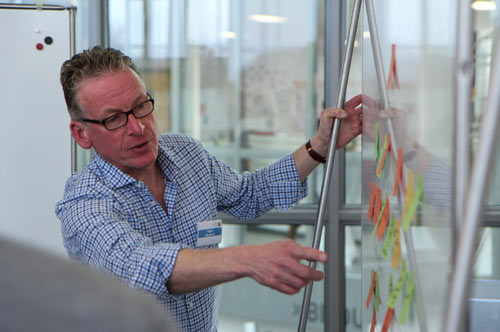Dynamic Facilitation Training Course
Dynamic Facilitation is a systemic method often applied to change dynamical systems like teams, projects and organizations. It offers space to participants to exchange all of their views and opinions rationally and emotionally without being blocked by a strict standard or guidance. By creating choices this method allows the appearance of spontaneous results (emergence).
Dynamic Facilitation enables participants to rearrange their thoughts and emotions especially in complex tasks or in conflict situations to find a creative and trustful solution. Dynamic Facilitation means to solve conflicts by releasing creativity.
This course will practice how to deal with complex tasks often covered by emotional obstacles. Taking a real example to be defined at the beginning by the team the participants will work along this real case using the method of Dynamic Facilitation.

How Dynamic Facilitation works
- Session 1: Create a common understanding among each participant on the entire picture, i.e. a brief DNA-analysis of the problem or challenge.
- Session 2: Participants will admit themselves to a creative process.
- Session 3: Choices will be created to allow the spontaneous appearance of results so a common breakthrough will be achieved.
- Session 4: Enough space will be given to think about the process and all arguments said and heard.
During all steps the participants are asked to articulate and discuss all aspects openly, rationally, emotionally, poorly sorted, without guidance and without any restriction. All aspects will be carefully heard and categorized into
Challenges | Questions
• How might we re-design / improve / optimize … (something like a product, a service, a process, team spirit, etc.)...
for … (a person, target group, user, customer, etc.)...
under consideration of ... (circumstances, problems, requirements, changes, etc.) ... ?
Ideas | Solutions
• spontaneous ideas, first approaches of solutions
Concerns | Objections | Apprehension
• "Will never work …!"
Information | Point of View
• "We never did it like this …!"
- Emotional arguments are volitional and will clean the situation successively. Participants feel they are heard. During the categorization the discussion should be kept floating.
- All concerns will be taken and noted without evaluation. Often there will be and must be a break by the moderator to get the situation quite and leave time for the team to think about what has been discussed and heard. That’s the essential phase of a breakthrough, the spontaneous appearance of solutions.
- After the breakthrough the team members – not the moderator - will start spontaneously in giving statements of integrative convergence rather than divergence heading towards a solution.
- Taking those integrative statements after some discussion there finally will come up a common agreement throughout the whole team.
- The solution will come out of the room / team, standing to reason for all team members.
Learning Objectives of the method for Dynamic Facilitation
This method will not only help to solve a particular problem, but it also orchestrates a team building process. After some exercises one of the team-member with talent and skills to moderate should be capable to use the method for all similar challenges in the future without the support of the moderator.
General skills- Learn not to shrink back even from complex situation. They can successfully be solved in a systematic manner.
- Experience that every challenge and obstacle has a rational and emotional component.
- Realize that one should also allow the expression of emotional arguments and concerns to understand obstacles in a situation that rationally seems easy to manage.
- Feel that Team means human factor, also in the business world.
- How to elaborate and formulate a problem in only one sharp question.
- The sharper the formulation of the question the better the discussion and solution.
- Leave room to express your emotions but also train to catch them.
- Learn to practice the method of Dynamic Facilitation.
